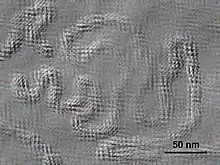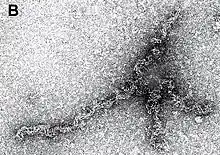Aspiviridae
Aspiviridae, formerly Ophioviridae, is a family of segmented negative-strand RNA viruses which infect plants. Member viruses are characterized by an elongated and highly filamentous and flexible nucleocapsid with helical symmetry.[1] It is a monotypic taxon containing only one genus, Ophiovirus.[2] Aspiviridae is also the only family in the order Serpentovirales, which in turn is the only order in the class Milneviricetes.[3]
| Ophiovirus | |
|---|---|
 | |
 | |
| (top) Electron micrograph of Citrus psorosis ophiovirus; (bottom) Mirafiori lettuce big-vein virus genome | |
| Virus classification | |
| (unranked): | Virus |
| Realm: | Riboviria |
| Kingdom: | Orthornavirae |
| Phylum: | Negarnaviricota |
| Class: | Milneviricetes |
| Order: | Serpentovirales |
| Family: | Aspiviridae |
| Genus: | Ophiovirus |
| Species | |

History
The name Aspiviridae derives from the Latin aspis (snake or viper), referring to the shape, along with the suffix for a virus family -viridae.[4] Ophiovirus derives from the Ancient Greek ophis, “snake”, with –virus the suffix for a virus genus.[5] Likewise, Serpentovirales is from "serpent" with -virales the suffix for a virus order.[4] Milneviricetes is in honor of Robert G. Milne, the last author on the first paper describing ophioviruses.[4][6]
Virology
Structure
The protein capsid is non-enveloped and has a constant diameter of 1500–2500 nm and a width of 3 nm, or 9 nm. The capsids form kinked circles, which can collapse to form linear duplex structures, much like a spring.[3]
Genome
Member viruses have segmented, negative-sense, single-stranded RNA genomes. The entire genome is 11000–12000 nucleotides long.[3][7]
Taxonomy

The family has one genus, Ophiovirus, which has seven recognized species. Members of both the family and the genus are referred to as ophioviruses.[3]
- Family: Aspiviridae
- Genus: Ophiovirus
- Species: (Past name; New name)
- Blueberry mosaic associated ophiovirus; Ophiovirus vaccinii
- Citrus psorosis ophiovirus; Ophiovirus citri
- Freesia sneak ophiovirus; Ophiovirus freesiae
- Lettuce ring necrosis ophiovirus; Ophiovirus lactucae
- Mirafiori lettuce big-vein ophiovirus; Ophiovirus mirafioriense
- Ranunculus white mottle ophiovirus; Ophiovirus ranunculi
- Tulip mild mottle mosaic ophiovirus; Ophiovirus tulipae
- Species: (Past name; New name)
- Genus: Ophiovirus
References
- García, María Laura; Bó, Elena Dal; da Graça, John V.; Gago-Zachert, Selma; Hammond, John; Moreno, Pedro; Natsuaki, Tomohide; Pallás, Vicente; Navarro, Jose A.; Reyes, Carina A.; Luna, Gabriel Robles; Sasaya, Takahide; Tzanetakis, Ioannis E.; Vaira, Anna María; Verbeek, Martin (21 June 2017). "ICTV Virus Taxonomy Profile: Ophioviridae". Journal of General Virology. 98 (6): 1161–1162. doi:10.1099/jgv.0.000836. PMC 5656789. PMID 28635587.
- "Virus Taxonomy: 2018 Release". International Committee on Taxonomy of Viruses (ICTV). Retrieved 14 January 2019.
- "ICTV Report Ophioviridae".
- Wolf, Yuri; Krupovic, Mart; Zhang, Yong Zhen; Maes, Piet; Dolja, Valerian; Koonin, Eugene V.; Kuhn, Jens H. "Megataxonomy of negative-sense RNA viruses" (docx). International Committee on Taxonomy of Viruses (ICTV). Retrieved 12 January 2019.
- "Aspiviridae – Aspiviridae – Negative-sense RNA Viruses - ICTV". talk.ictvonline.org. Retrieved 2020-12-09.
- García, Maria Laura; Dal Bó, Elena; Grau, Oscar; Milne, Robert G. (1 December 1994). "The closely related citrus ringspot and citrus psorosis viruses have particles of novel filamentous morphology". Journal of General Virology. 75 (12): 3585–3590. doi:10.1099/0022-1317-75-12-3585. ISSN 0022-1317. OCLC 107178738. PMID 7996151.
- ICTVdB Management (2006). 00.094.0.01. Ophiovirus. In: ICTVdB—The Universal Virus Database, version 4. Büchen-Osmond, C. (Ed), Columbia University, New York, USA.